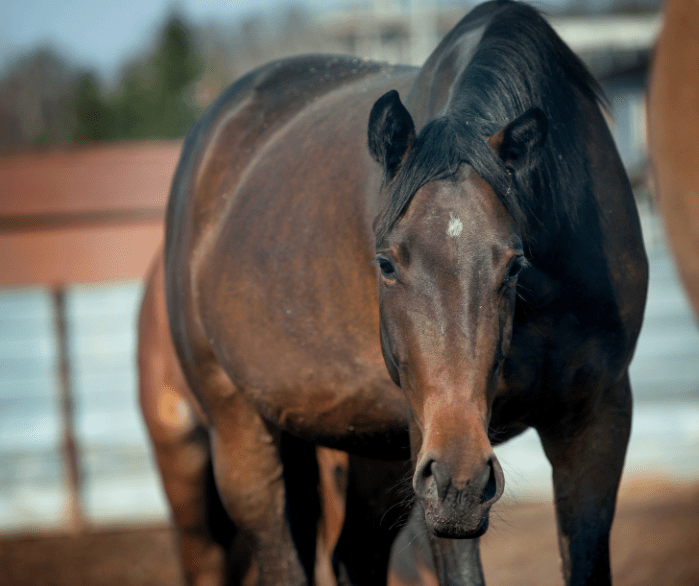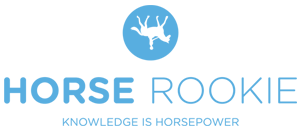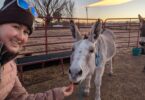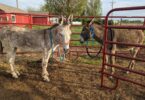Off to a bad start
Sahara, a six-year-old beautiful bay Arabian mare, was arriving today. There is always such grand excitement when a new horse arrives to the barn. Most people want to get to know the new horse, and the owner. Folks want to find out what the personality and background of the new arrival is, and so on. This time was no different.
What put Sahara at risk was that her owners were new horse people. They purchased Sahara from Craigslist and didn’t care to do much with her, but to lead her around like a dog. Sahara, being far from a dog, was spirited and gave her owners the runaround. Not even six months passed before they had to sell her.
The next woman who bought Sahara had been around horses because 1) her husband had a couple of his own and 2) he was friends with people in the rodeo circuit. He had handled many Quarter Horses over the years and knew his way around them.
Together, this couple wanted to take on Sahara, who was clearly a project horse. The wife was admittedly inexperienced with training and even riding. After listening to her friends and husband talk about training, though, she thought she knew what to do: she needed to be ‘the boss.’

Photo Credit: Canva
She took responsible steps to get this wild horse’s feet trimmed, get her the shots she needed, and to deworm her. But she also thought ownership implied asserting her dominance over Sahara. She brought over some friends to help her, collecting tips on how to be dominant. As she started working with Sahara, however, being the boss was a struggle. Sahara was hot, aggressive, and had been allowed to get her way for far too long.
What made matters worse were the voices around her saying she wasn’t doing enough to get her horse under control. Sahara’s new owner—intending to be her leader and caretaker—was becoming the punisher. But it wasn’t just her owner. It was all the people who offered to “help” with Sahara.
The punishments escalated, far beyond what I considered necessary, and seemed to characterize most of Sahara’s handling.
She was bullied with a whip during lunging, run around the arena over and over with no purpose, and smacked around with various ropes (possibly worse). Yet these tactics did more to confuse and intimidate her rather than teach her. Within a few months, Sahara was moved to a training barn.
I’m not sure what became of her, but sadly, this lose-lose (rider-horse) scenario is common in the horse world. Strive to avoid this cycle.
If the horse loses, so does the rider.
I have seen far too frequently the phenomena of punishment taking the place of training. Sometimes, it happens so innocently that we don’t even realize that we’ve fallen into it. Other times, it is impatience that grows over time into cruelty. Whatever the cause, it needs to stop.
 How the Punishment Cycle Occurs
How the Punishment Cycle Occurs
Discipline is an indispensable part of training. We must show our horses, through boundaries, the consequences of unsafe, aggressive, or undesired behavior. We give them parameters to make them understand how they will be accepted under our leadership. Keeping within these boundaries, they are rewarded and safe.
Our task of providing consequences should always, ultimately, benefit the horse. Furthermore, it should never inflict actual harm. For example, a horse that acts safe around humans will almost always be well cared for. So it is to their benefit to act politely around humans, and a reason to draw boundaries around impolite behavior. Disciplining your horse when they act outside of these boundaries will demonstrate their importance.
Some horses test boundaries more than others, and this is natural. Dealing with such horses is often how we develop the prejudice in our mind that we need to be harsh all the time in order to maintain the power dynamic. Our own impatience, confusion and frustration may cause us to inflict a consequence even when not necessary. This is especially true when we do not listen to what our horse tries to communicate to us (such as pain, confusion, or fear).

Photo Credit: Canva
This cycle solidifies over time when we begin to discipline our horse as a response to our own insecurity, instead of their wrongdoing. When we are afraid of our horse, or don’t know what to do in a given training moment, resorting to punishment is an easy out. At the very least we are putting him in his place, right?
When this response becomes a habit, the punishment mentality becomes our default response.
Some people are taught that punishment is a crucial aspect of training from the beginning of their learning process with horses. They are taught to look for the horse to act up. Unfortunately, they think that when they have punished their horse, they have been productive in their training. In fact, the opposite is true. Training implies discipline, where poor behavior is met with a consequence.
When your horse offers no organic reason for you to discipline them, there is absolutely no reason to look for one.
This line of thinking will inevitably lead us to pushing our horses until they commit a punishable offense. Not only is this an incorrect approach to discipline, but it is a power trip. It is a cheap and backwards way to approach training. It sets up a dynamic where the horse can never win.
While we don’t want our horses to overpower us or change the dominance dynamic, we do want them to do well. We want them to know when they have done something right.
Breaking the Cycle
I believe that there are very few people who actually mean ill towards their horses. Most people who manifest this mentality care about their horses’ well-being and cherish their time with them. This makes me believe that most people are not aware that they are punishing out of turn, either because they were taught incorrectly or have grown tired in one way or another.
The outcome of this dynamic is a constant cycle of defeat, though. The horse will learn that no matter what, they will always lose. Depending on the horse’s personality type, they will either respond with tension, fear, aggression, or apathy.
Do you remember that one teacher in elementary school who nitpicked at your faults, perhaps even made an example of you in front of your peers? While the psychological implications aren’t as deep or shame-based, your horse will still experience the discomfort and lack of acceptance. From a pack mentality, they sense a lack of protection and stability, and internalize a need to fend for themselves.
The antidote for this mentality is to approach your horse with the mindset that it can and will please you.
Instead of looking for how it will misbehave or underperform, look for the positive in her performance. While bad habits will rise to the surface, deal with them when they happen instead of going to look for them.
This is the difference between discipline and punishment: seeking to build them up in trust and dependency, as opposed tearing them down.

Photo Credit: Canva
Leadership is about boundaries and kindness working together, not power for power’s sake. We want our horses to win, to feel safe, and feel like they have pleased us.
This will encourage them to keep seeking reward, rather than fearing the inevitable and unpredictable punishment. They will know that their time with us always involves a pleasant experience, even if discipline is present.
When our horses win, we win too.
Frequently Asked Questions
How do you motivate a horse?
The most effective way to motivate a horse is with positive reinforcement. This quickly teaches the horse to respond to the thing in the desired way. Negative reinforcement is not ineffective (otherwise it wouldn’t exist), but will not create as much of a willing, healthy partnership between horse and rider. Negative reinforcement can also result in an animal that is fearful and reactive.
On the ground, you could motivate a horse with food. For example, if the horse picks up his foot when asked, he may be rewarded with a treat such as a carrot. While mounted, a reward might be a pat or stroke on the neck when the horse does something very well. Another type of motivation can be to stop doing something. For example, to get a horse to stop, you might pull back on the reins. This creates pressure in the mouth. When the horse stops, the rider would release the reins, removing the source of the pressure. This would be more comfortable for the horse and is a reward of sorts.
How do you motivate a horse with treats?
Horses are intelligent and can connect actions with outcomes. A good rule of thumb is to use a three-second rule. If a horse does something well, you should reward that behavior within three seconds to positively correlate the “ask” with the desired outcome.
Treats can be used for groundwork, such as asking the horse to stretch his neck around to the left and rewarding the movement with food. Using food for motivation is not, however, the most common method of training. (It’s not very convenient to try to feed a horse a treat while in the saddle, with a bit in the horse’s mouth!).
It is more common to give a horse a treat at the end of a good ride, after the horse is properly cooled down. You don’t want to give treats or grain to a hot, sweaty horse. Always ask permission before feeding someone else’s horse a treat; some horses have dietary restrictions. Other horses can get “mouthy” if hand-fed.
Is horse punishment necessary?
Horses learn best with positive reinforcement. There are circumstances where negative reinforcement, however, may be necessary. For example, if a horse tries to bite a human, that would warrant a negative reinforcement—that is a dangerous behavior that should not be tolerated. The behavior must be immediately corrected (think: a 3 second window) so the horse understands what action led to the consequence.
Another example is the “ask, tell, command” training technique. If I “ask” the horse to walk forward (a gentle tap with heel) and he does not, I will move to “telling” him to move forward. This means I would escalate the gentle tap to a stronger, more noticeable squeeze. If that fails to move the horse forward, I would escalate again and now “command” him to move forward. This might mean a kick to get him to go. It is important that the horse does the thing you asked—if you don’t escalate the “ask” when the horse ignores you, you just trained him that he doesn’t have to listen to you.
How do you make a horse behave?
The key to training a horse is consistency. Horses respond best to positive reinforcement. If you ask a horse to do something and he does it, rewarding him with a pat, a verbal “good job,” or even a cookie will teach him to respond the same way in the future. If you ask a horse to do something (reasonable) and he does not do it, you must continue to ask until he does it. If you give up and do not make him do the thing, you’ve taught him that he doesn’t have to listen to you.
It is best to “ask” nicely, then escalate the ask based on the resistance you are getting in return. You don’t want to have to kick your horse every time to get him to move forward—a gentle nudge of the heel would be much easier for you and more pleasant for him. Gradually increase your ask until it exceeds the horse’s resistance. This also gives him the opportunity to respond before you have to escalate your ask, so next time it may take less effort on your part as the horse learns what is expected.
Should you ever hit a horse?
Horses respond best to positive reinforcement. That said, horses are much, much larger than humans and can be dangerous if they learn bad behaviors. An example of when it might be appropriate to hit a horse is if the horse tries to kick or bite a human.
In this example, I’ve smacked my horse before using the palm of my hand. This wasn’t enough to physically hurt him—it did not leave a mark, but it startled him and immediately let him know that his behavior was unacceptable.
Some horses may need to be tapped with a crop to reinforce the rider’s leg. This is more commonly seen when jumping. If a horse refuses a jump at the last second (called a “dirty stop”) this can be very dangerous for the rider, who may be thrown off the horse and into or over the jump. The rider may use a crop behind the girth to encourage him to go over the fence.
Breed associations have very specific rules about when, how, and how many times you may hit a horse with a crop in the show pen. Always work with a trainer or experienced equine professional if you are dealing with dangerous behaviors that may require negative reinforcement—it takes experience to read body language and respond appropriately. There is a fine line between an appropriate reaction to a negative behavior, and horse abuse, that should never be crossed.
P.S. Enjoy this article? Trot on over to:
- Why horses are dangerous (but worth the risk!)
- Scared to ride your horse? Get your mojo back
- How can I calm my nerves before horse riding?
- 3 Fear-Free Secrets to Gain Your Horse’s Trust & Respect
- How to Challenge the Challenging Horse








